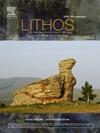Shear zone memory revealed by in-situ Rb-Sr and 40Ar/39Ar dating of Pyrenean and Alpine tectonic phases in the external Alps
IF 2.5
2区 地球科学
Q2 GEOCHEMISTRY & GEOPHYSICS
引用次数: 0
Abstract
The combination of Rb-Sr and 40Ar/39Ar dating methods with high-resolution mineralogical investigation allows deciphering the multiphase history of shear zones and serves as a tool for tectonic reconstructions. However, the interpretation of dates obtained by these two methods in relation to cooling, fluid circulation or to deformation-induced (re)crystallization remains controversial. Here, we apply the in situ 87Rb/87Sr and 40Ar/39Ar dating methods to shear zone minerals used together with step heating 40Ar/39Ar dating in several case studies with contrasting structural and metamorphic histories along the External Crystalline Massifs (ECMs) of the SW Alps. Our results emphasize polyphase deformation and highlight a variable behaviour of Rb-Sr and K-Ar systems in shear zones. This study provides new constraints about the timing, conditions and mechanisms of deformation in the southern ECMs of the Western Alps. The inherited crustal-scale Variscan shear zones have been reactivated several times in a thick-skin mode since the Late Cretaceous. An early N-S compressional phase impacted the SW Alps mainly at around ∼80–70 and ∼40 Ma in the Argentera and Pelvoux shear zones, but this signal is not documented further north. This signal is better preserved in the southern Pelvoux massif, with a Rb-Sr age of 79.7 ± 3.7 Ma. There is also a significant compressional deformation on the W-Alpine scale at 34–32 Ma, associated with underthrusting beneath the Penninic Frontal Thrust (PFT). Two compressional deformation pulses occur at 26 and 22–20 Ma in the southern Argentera Massif, corresponding to the onset of transpressive deformation induced by the anti-clockwise rotation of the Adriatic Plate. Finally, the last phase of deformation around 18–15 Ma concerns only the NW Alps, in the Beaufortain massif, which was buried under the Mont-Blanc massif, during the propagation of deformation leading to the development of the frontal fold and thrust belt of the SW Alps. Our results also show that the southern Pelvoux massif already reached a temperature around 300 °C at a depth of 10–15 km depth during the Late Cretaceous. This range of temperature and pressure conditions is broadly similar to that reached in the ECMs during the Cenozoic deformation stages.
外阿尔卑斯山脉比利牛斯山脉和阿尔卑斯山脉构造阶段原位Rb-Sr和40Ar/39Ar测年揭示的剪切带记忆
Rb-Sr和40Ar/39Ar测年方法与高分辨率矿物学调查相结合,可以破译剪切带的多阶段历史,并作为构造重建的工具。然而,对这两种方法获得的数据的解释与冷却、流体循环或变形诱导(再)结晶有关,仍然存在争议。本文采用原位87Rb/87Sr和40Ar/39Ar测年方法对剪切带矿物进行测年,并结合台阶加热40Ar/39Ar测年,对阿尔卑斯西南缘外部结晶地块(ECMs)的构造和变质历史进行对比研究。我们的结果强调了多相变形,并强调了剪切带中Rb-Sr和K-Ar体系的可变行为。这一研究为西阿尔卑斯山脉南部ecm的变形时间、条件和机制提供了新的约束条件。自晚白垩世以来,继承的地壳尺度的瓦里斯坎剪切带多次以厚皮模式被重新激活。早期的南北向挤压期主要在~ 80-70和~ 40 Ma左右在阿根廷和Pelvoux剪切带对西南阿尔卑斯山脉产生影响,但在更北的地方没有记录到这一信号。该信号在Pelvoux地块南部保存较好,Rb-Sr年龄为79.7±3.7 Ma。在34-32 Ma的西阿尔卑斯尺度上也存在明显的挤压变形,这种变形与盆前冲断(PFT)下的逆冲作用有关。阿根廷地块南部在26和22-20 Ma出现了两个挤压变形脉冲,对应于亚得里亚海板块逆时针旋转引起的逆挤压变形的开始。最后一期变形发生在18-15 Ma左右,仅发生在勃朗峰下的Beaufortain地块内的西北阿尔卑斯山脉,变形传播导致了西南阿尔卑斯山脉前缘褶皱和冲断带的发育。我们的研究结果还表明,在晚白垩纪,Pelvoux地块南部在10-15公里深处的温度已经达到了300°C左右。这一温度和压力条件范围与中生代变形阶段的温度和压力条件范围大致相似。
本文章由计算机程序翻译,如有差异,请以英文原文为准。
求助全文
约1分钟内获得全文
求助全文
来源期刊

Lithos
地学-地球化学与地球物理
CiteScore
6.80
自引率
11.40%
发文量
286
审稿时长
3.5 months
期刊介绍:
Lithos publishes original research papers on the petrology, geochemistry and petrogenesis of igneous and metamorphic rocks. Papers on mineralogy/mineral physics related to petrology and petrogenetic problems are also welcomed.
 求助内容:
求助内容: 应助结果提醒方式:
应助结果提醒方式:


